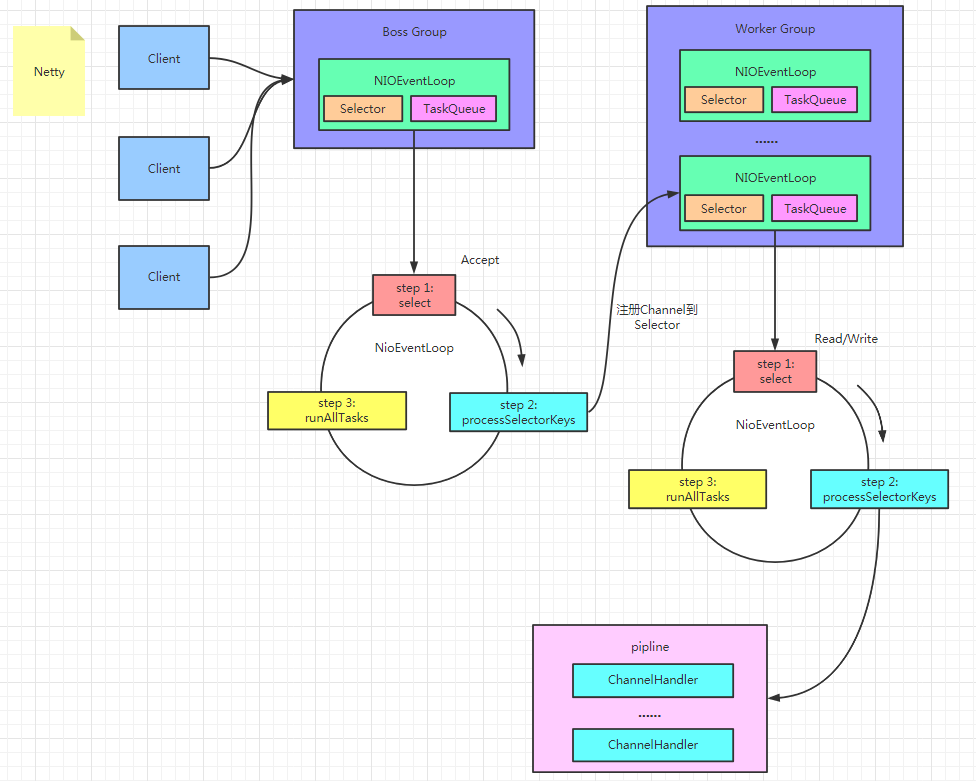Netty线程模型

模型解释:
-
Netty 抽象出两组线程池BossGroup和WorkerGroup,BossGroup专门负责接收客户端的连接, WorkerGroup专门负责网络的读写
-
BossGroup和WorkerGroup类型都是NioEventLoopGroup
-
NioEventLoopGroup 相当于一个事件循环线程组, 这个组中含有多个事件循环线程 , 每一个事件循环线程是NioEventLoop
-
每个NioEventLoop都有一个selector , 用于监听注册在其上的socketChannel的网络通讯
-
每个Boss NioEventLoop线程内部循环执行的步骤有 3 步
- 处理accept事件 , 与client 建立连接 , 生成 NioSocketChannel
- 将NioSocketChannel注册到某个worker NIOEventLoop上的selector
- 处理任务队列的任务 , 即runAllTasks
- 每个worker NIOEventLoop线程循环执行的步骤
- 轮询注册到自己selector上的所有NioSocketChannel 的read, write事件
- 处理 I/O 事件, 即read , write 事件, 在对应NioSocketChannel 处理业务
- runAllTasks处理任务队列TaskQueue的任务 ,一些耗时的业务处理一般可以放入TaskQueue中慢慢处理,这样不影响数据在 pipeline 中的流动处理
- 每个worker NIOEventLoop处理NioSocketChannel业务时,会使用 pipeline (管道),管道中维护了很多 handler 处理器用来处理 channel 中的数据
Netty模块组件
【Bootstrap、ServerBootstrap】:
Bootstrap 意思是引导,一个 Netty 应用通常由一个 Bootstrap 开始,主要作用是配置整个 Netty 程序,串联各个组件,Netty 中 Bootstrap 类是客户端程序的启动引导类,ServerBootstrap 是服务端启动引导类。
【Future、ChannelFuture】:
正如前面介绍,在 Netty 中所有的 IO 操作都是异步的,不能立刻得知消息是否被正确处理。
但是可以过一会等它执行完成或者直接注册一个监听,具体的实现就是通过 Future 和 ChannelFutures,他们可以注册一个监听,当操作执行成功或失败时监听会自动触发注册的监听事件。
【Channel】:
Netty 网络通信的组件,能够用于执行网络 I/O 操作。Channel 为用户提供:
1)当前网络连接的通道的状态(例如是否打开?是否已连接?)
2)网络连接的配置参数 (例如接收缓冲区大小)
3)提供异步的网络 I/O 操作(如建立连接,读写,绑定端口),异步调用意味着任何 I/O 调用都将立即返回,并且不保证在调用结束时所请求的 I/O 操作已完成。
4)调用立即返回一个 ChannelFuture 实例,通过注册监听器到 ChannelFuture 上,可以 I/O 操作成功、失败或取消时回调通知调用方。
5)支持关联 I/O 操作与对应的处理程序。
不同协议、不同的阻塞类型的连接都有不同的 Channel 类型与之对应。
下面是一些常用的 Channel 类型:
- NioSocketChannel,异步的客户端 TCP Socket 连接。
- NioServerSocketChannel,异步的服务器端 TCP Socket 连接。
- NioDatagramChannel,异步的 UDP 连接。
- NioSctpChannel,异步的客户端 Sctp 连接。
- NioSctpServerChannel,异步的 Sctp 服务器端连接,这些通道涵盖了 UDP 和 TCP 网络 IO 以及文件 IO。
【Selector】:
Netty 基于 Selector 对象实现 I/O 多路复用,通过 Selector 一个线程可以监听多个连接的 Channel 事件。
当向一个 Selector 中注册 Channel 后,Selector 内部的机制就可以自动不断地查询(Select) 这些注册的 Channel 是否有已就绪的 I/O 事件(例如可读,可写,网络连接完成等),这样程序就可以很简单地使用一个线程高效地管理多个 Channel 。
【NioEventLoop】:
NioEventLoop 中维护了一个线程和任务队列,支持异步提交执行任务,线程启动时会调用 NioEventLoop 的 run 方法,执行 I/O 任务和非 I/O 任务:
I/O 任务,即 selectionKey 中 ready 的事件,如 accept、connect、read、write 等,由 processSelectedKeys 方法触发。
非 IO 任务,添加到 taskQueue 中的任务,如 register0、bind0 等任务,由 runAllTasks 方法触发。
【NioEventLoopGroup】:
NioEventLoopGroup,主要管理 eventLoop 的生命周期,可以理解为一个线程池,内部维护了一组线程,每个线程(NioEventLoop)负责处理多个 Channel 上的事件,而一个 Channel 只对应于一个线程。
【ChannelHandler】:
ChannelHandler 是一个接口,处理 I/O 事件或拦截 I/O 操作,并将其转发到其 ChannelPipeline(业务处理链)中的下一个处理程序。
ChannelHandler 本身并没有提供很多方法,因为这个接口有许多的方法需要实现,方便使用期间,可以继承它的子类:
- ChannelInboundHandler 用于处理入站 I/O 事件。
- ChannelOutboundHandler 用于处理出站 I/O 操作。
或者使用以下适配器类:
- ChannelInboundHandlerAdapter 用于处理入站 I/O 事件。
- ChannelOutboundHandlerAdapter 用于处理出站 I/O 操作。
【ChannelHandlerContext】:
保存 Channel 相关的所有上下文信息,同时关联一个 ChannelHandler 对象。
【ChannelPipline】:
保存 ChannelHandler 的 List,用于处理或拦截 Channel 的入站事件和出站操作。
ChannelPipeline 实现了一种高级形式的拦截过滤器模式,使用户可以完全控制事件的处理方式,以及 Channel 中各个的 ChannelHandler 如何相互交互。
在 Netty 中每个 Channel 都有且仅有一个 ChannelPipeline 与之对应,它们的组成关系如下:

一个 Channel 包含了一个 ChannelPipeline,而 ChannelPipeline 中又维护了一个由 ChannelHandlerContext 组成的双向链表,并且每个 ChannelHandlerContext 中又关联着一个 ChannelHandler。
read事件(入站事件)和write事件(出站事件)在一个双向链表中,入站事件会从链表 head 往后传递到最后一个入站的 handler,出站事件会从链表 tail 往前传递到最前一个出站的 handler,两种类型的 handler 互不干扰。
Netty Demo
引入依赖
<dependency>
<groupId>io.netty</groupId>
<artifactId>netty-all</artifactId>
<version>4.1.35.Final</version>
</dependency>
Server
public class NettyServer {
public static void main(String[] args) throws Exception {
//创建两个线程组bossGroup和workerGroup, 含有的子线程NioEventLoop的个数默认为cpu核数的两倍
// bossGroup只是处理连接请求 ,真正的和客户端业务处理,会交给workerGroup完成
EventLoopGroup bossGroup = new NioEventLoopGroup(1);
EventLoopGroup workerGroup = new NioEventLoopGroup();
try {
//创建服务器端的启动对象
ServerBootstrap bootstrap = new ServerBootstrap();
//使用链式编程来配置参数
bootstrap.group(bossGroup, workerGroup) //设置两个线程组
.channel(NioServerSocketChannel.class) //使用NioServerSocketChannel作为服务器的通道实现
// 初始化服务器连接队列大小,服务端处理客户端连接请求是顺序处理的,所以同一时间只能处理一个客户端连接。
// 多个客户端同时来的时候,服务端将不能处理的客户端连接请求放在队列中等待处理
.option(ChannelOption.SO_BACKLOG, 1024)
.childHandler(new ChannelInitializer<SocketChannel>() {//创建通道初始化对象,设置初始化参数
@Override
protected void initChannel(SocketChannel ch) throws Exception {
//对workerGroup的SocketChannel设置处理器
ch.pipeline().addLast(new NettyServerHandler());
}
});
System.out.println("netty server start。。");
//绑定一个端口并且同步, 生成了一个ChannelFuture异步对象,通过isDone()等方法可以判断异步事件的执行情况
//启动服务器(并绑定端口),bind是异步操作,sync方法是等待异步操作执行完毕
ChannelFuture cf = bootstrap.bind(9000).sync();
//给cf注册监听器,监听我们关心的事件
/*cf.addListener(new ChannelFutureListener() {
@Override
public void operationComplete(ChannelFuture future) throws Exception {
if (cf.isSuccess()) {
System.out.println("监听端口9000成功");
} else {
System.out.println("监听端口9000失败");
}
}
});*/
//对通道关闭进行监听,closeFuture是异步操作,监听通道关闭
// 通过sync方法同步等待通道关闭处理完毕,这里会阻塞等待通道关闭完成
cf.channel().closeFuture().sync();
} finally {
bossGroup.shutdownGracefully();
workerGroup.shutdownGracefully();
}
}
}
Server Channel Handler
public class NettyServerHandler extends ChannelInboundHandlerAdapter {
@Override
public void channelActive(ChannelHandlerContext ctx) throws Exception {
System.out.println("有客户端建立了连接");
}
/**
* 读取客户端发送的数据
*
* @param ctx 上下文对象, 含有通道channel,管道pipeline
* @param msg 就是客户端发送的数据
* @throws Exception
*/
@Override
public void channelRead(ChannelHandlerContext ctx, Object msg) throws Exception {
System.out.println("服务器读取线程 " + Thread.currentThread().getName());
//Channel channel = ctx.channel();
//ChannelPipeline pipeline = ctx.pipeline(); //本质是一个双向链接, 出站入站
//将 msg 转成一个 ByteBuf,类似NIO 的 ByteBuffer
ByteBuf buf = (ByteBuf) msg;
System.out.println("客户端发送消息是:" + buf.toString(CharsetUtil.UTF_8));
}
/**
* 数据读取完毕处理方法
*
* @param ctx
* @throws Exception
*/
@Override
public void channelReadComplete(ChannelHandlerContext ctx) throws Exception {
ByteBuf buf = Unpooled.copiedBuffer("HelloClient", CharsetUtil.UTF_8);
ctx.writeAndFlush(buf);
}
/**
* 处理异常, 一般是需要关闭通道
*
* @param ctx
* @param cause
* @throws Exception
*/
@Override
public void exceptionCaught(ChannelHandlerContext ctx, Throwable cause) throws Exception {
ctx.close();
}
}
Client
public class NettyClient {
public static void main(String[] args) throws Exception {
//客户端需要一个事件循环组
EventLoopGroup group = new NioEventLoopGroup();
try {
//创建客户端启动对象
//注意客户端使用的不是 ServerBootstrap 而是 Bootstrap
Bootstrap bootstrap = new Bootstrap();
//设置相关参数
bootstrap.group(group) //设置线程组
.channel(NioSocketChannel.class) // 使用 NioSocketChannel 作为客户端的通道实现
.handler(new ChannelInitializer<SocketChannel>() {
@Override
protected void initChannel(SocketChannel channel) throws Exception {
//加入处理器
channel.pipeline().addLast(new NettyClientHandler());
}
});
System.out.println("netty client start");
//启动客户端去连接服务器端
ChannelFuture channelFuture = bootstrap.connect("127.0.0.1", 9000).sync();
//对关闭通道进行监听
channelFuture.channel().closeFuture().sync();
} finally {
group.shutdownGracefully();
}
}
}
Client Channel Handler
public class NettyClientHandler extends ChannelInboundHandlerAdapter {
/**
* 当客户端连接服务器完成就会触发该方法
*
* @param ctx
* @throws Exception
*/
@Override
public void channelActive(ChannelHandlerContext ctx) throws Exception {
ByteBuf buf = Unpooled.copiedBuffer("HelloServer", CharsetUtil.UTF_8);
ctx.writeAndFlush(buf);
}
//当通道有读取事件时会触发,即服务端发送数据给客户端
@Override
public void channelRead(ChannelHandlerContext ctx, Object msg) throws Exception {
ByteBuf buf = (ByteBuf) msg;
System.out.println("收到服务端的消息:" + buf.toString(CharsetUtil.UTF_8));
System.out.println("服务端的地址: " + ctx.channel().remoteAddress());
}
@Override
public void exceptionCaught(ChannelHandlerContext ctx, Throwable cause) throws Exception {
cause.printStackTrace();
ctx.close();
}
}
Netty 聊天室 Demo
引入依赖
<dependency>
<groupId>io.netty</groupId>
<artifactId>netty-all</artifactId>
<version>4.1.35.Final</version>
</dependency>
<dependency>
<groupId>com.alibaba</groupId>
<artifactId>fastjson</artifactId>
<version>1.2.70</version>
</dependency>
WrapMessage(用于封装消息)
public class WrapMessage implements Serializable {
private static final long serialVersionUID = 3165017226845753050L;
/**
* 1.注册 2.群发 3.私聊
*/
private int type;
private String username;
private String message;
public WrapMessage(){}
public int getType() {
return type;
}
public void setType(int type) {
this.type = type;
}
public String getMessage() {
return message;
}
public void setMessage(String message) {
this.message = message;
}
@Override
public String toString() {
return "WrapMessage{" +
"type=" + type +
", message='" + message + '\'' +
'}';
}
public String getUsername() {
return username;
}
public void setUsername(String username) {
this.username = username;
}
}
Chat Server
public class ChatServer {
public static void main(String[] args) {
EventLoopGroup bossGroup = new NioEventLoopGroup(1);
EventLoopGroup workerGroup = new NioEventLoopGroup();
try {
ServerBootstrap bootstrap = new ServerBootstrap();
bootstrap.group(bossGroup, workerGroup)
.channel(NioServerSocketChannel.class)
.option(ChannelOption.SO_BACKLOG, 1024)
.childHandler(new ChannelInitializer<SocketChannel>() {
@Override
protected void initChannel(SocketChannel socketChannel) throws Exception {
ChannelPipeline pipeline = socketChannel.pipeline();
//向pipeline加入解码器
pipeline.addLast("decoder", new StringDecoder());
//向pipeline加入编码器
pipeline.addLast("encoder", new StringEncoder());
pipeline.addLast(new ChatServerHandler());
}
});
System.out.println("netty server start。。");
//绑定一个端口并且同步, 生成了一个ChannelFuture异步对象,通过isDone()等方法可以判断异步事件的执行情况
//启动服务器(并绑定端口),bind是异步操作,sync方法是等待异步操作执行完毕
ChannelFuture cf = bootstrap.bind(9000).sync();
//给cf注册监听器,监听我们关心的事件
/*cf.addListener(new ChannelFutureListener() {
@Override
public void operationComplete(ChannelFuture future) throws Exception {
if (cf.isSuccess()) {
System.out.println("监听端口9000成功");
} else {
System.out.println("监听端口9000失败");
}
}
});*/
//对通道关闭进行监听,closeFuture是异步操作,监听通道关闭
// 通过sync方法同步等待通道关闭处理完毕,这里会阻塞等待通道关闭完成
cf.channel().closeFuture().sync();
} catch (InterruptedException e) {
e.printStackTrace();
} finally {
bossGroup.shutdownGracefully();
workerGroup.shutdownGracefully();
}
}
}
Chat Server Channel Handler
public class ChatServerHandler extends SimpleChannelInboundHandler<String> {
private static ChannelGroup channelGroup = new DefaultChannelGroup(GlobalEventExecutor.INSTANCE);
private static Map<String, String> userMap = new ConcurrentHashMap<>();
private static Map<String, Channel> channelMap = new ConcurrentHashMap<>();
@Override
public void channelActive(ChannelHandlerContext ctx) throws Exception {
Channel channel = ctx.channel();
// String message = "[客户端]" + channel.remoteAddress() + " 上线了";
// System.out.println(message);
// channelGroup.writeAndFlush(message);
channelGroup.add(channel);
}
private void userLogin(String username, Channel channel) {
String address = channel.remoteAddress().toString();
userMap.put(address, username);
channelMap.put(username, channel);
channelGroup.writeAndFlush(username + " 进入了聊天室");
}
private void sendMessageToAll(String message, Channel channel) {
String address = channel.remoteAddress().toString();
String username = userMap.get(address);
channelGroup.writeAndFlush(username + ":" + message);
}
private void sendMessageToOne(String username, String message, Channel channel) {
String fromUser = userMap.get(channel.remoteAddress().toString());
Channel toChannel = channelMap.get(username);
String finalMessage = "用户" + fromUser + "向您发送了一条消息:" + message;
toChannel.writeAndFlush(finalMessage);
channel.writeAndFlush("您向" + username + "发送了一条消息:" + message);
}
@Override
protected void channelRead0(ChannelHandlerContext ctx, String messageJson) throws Exception {
Channel channel = ctx.channel();
WrapMessage wrapMessage = JSON.parseObject(messageJson, WrapMessage.class);
System.out.println("接收到服务端消息:" + wrapMessage);
int type = wrapMessage.getType();
switch (type) {
case 1:
userLogin(wrapMessage.getUsername(), channel);
break;
case 2:
sendMessageToAll(wrapMessage.getMessage(), channel);
break;
case 3:
sendMessageToOne(wrapMessage.getUsername(), wrapMessage.getMessage(), channel);
break;
}
//
// String clientMessage = "[客户端]" + channel.remoteAddress() + " :" + message;
// channelGroup.forEach(ch -> {
// if (ch != channel) {
// ch.writeAndFlush(clientMessage);
// } else {
// channel.writeAndFlush("[自己]:" + message);
// }
// });
}
@Override
public void channelInactive(ChannelHandlerContext ctx) throws Exception {
Channel channel = ctx.channel();
String address = channel.remoteAddress().toString();
String username = userMap.get(address);
String message = username + " 下线了";
userMap.remove(address);
channelMap.remove(username);
channelGroup.writeAndFlush(message);
System.out.println("channelGroup size=" + channelGroup.size());
}
}
Chat Client
public class ChatClient {
public static void main(String[] args) throws Exception {
//客户端需要一个事件循环组
EventLoopGroup group = new NioEventLoopGroup();
try {
//创建客户端启动对象
//注意客户端使用的不是 ServerBootstrap 而是 Bootstrap
Bootstrap bootstrap = new Bootstrap();
//设置相关参数
bootstrap.group(group) //设置线程组
.channel(NioSocketChannel.class) // 使用 NioSocketChannel 作为客户端的通道实现
.handler(new ChannelInitializer<SocketChannel>() {
@Override
protected void initChannel(SocketChannel channel) throws Exception {
ChannelPipeline pipeline = channel.pipeline();
pipeline.addLast(new StringEncoder());
pipeline.addLast(new StringDecoder());
pipeline.addLast(new ChatClientHandler());
}
});
System.out.println("netty client start");
//启动客户端去连接服务器端
ChannelFuture channelFuture = bootstrap.connect("127.0.0.1", 9000).sync();
//--------以下为业务逻辑代码
Channel channel = channelFuture.channel();
Scanner scanner = new Scanner(System.in);
System.out.print("您的用户名为:");
String username = scanner.nextLine();
WrapMessage wrapMessage = new WrapMessage();
wrapMessage.setType(1);
wrapMessage.setUsername(username);
ByteBuf buf = Unpooled.copiedBuffer(JSON.toJSONString(wrapMessage), CharsetUtil.UTF_8);
channel.writeAndFlush(buf);
System.err.println("按任意键开始发送消息,按[q]退出");
String s = scanner.nextLine();
if("q".equals(s)){
return;
}
System.out.print("您的消息类型(2.群发消息 3.私聊)为:");
while (scanner.hasNextLine()){
String type = scanner.nextLine();
int messageType = Integer.parseInt(type);
wrapMessage = new WrapMessage();
wrapMessage.setType(messageType);
if(messageType == 2){
System.out.print("您想发送的消息:");
}else if(messageType == 3){
System.out.print("您想发送的用户:");
username = scanner.nextLine();
wrapMessage.setUsername(username);
System.out.print("您想发送的消息:");
}
String message = scanner.nextLine();
wrapMessage.setMessage(message);
buf = Unpooled.copiedBuffer(JSON.toJSONString(wrapMessage), CharsetUtil.UTF_8);
channel.writeAndFlush(buf);
s = scanner.nextLine();
if("q".equals(s)){
return;
}
System.out.print("您的消息类型(1.注册 2.群发消息 3.私聊)为:");
}
//对关闭通道进行监听
channelFuture.channel().closeFuture().sync();
} finally {
group.shutdownGracefully();
}
}
}
Chat Client Channel Handler
public class ChatClientHandler extends SimpleChannelInboundHandler<String> {
@Override
protected void channelRead0(ChannelHandlerContext channelHandlerContext, String message) throws Exception {
System.out.println(message);
}
}
